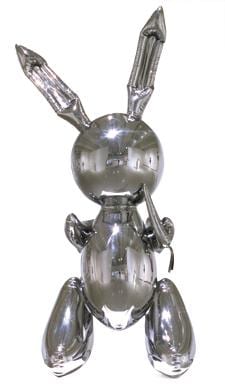You’re a sell-out.
It’s a charge that’s been levied against almost every artist who has experienced a measure of commercial success. Sometimes you can see what the critics are talking about, but often, it’s merely in reference to an artist becoming known to the mainstream public after a period of relative obscurity.
For a number of avant-garde artists using avenues like mass production, mainstream media and advertising to get their message across — and their art into the hands of a broader public — the ideal of the artist as the distant genius who disengages from the machinations of society to critique them from afar misses the point.
The National Gallery’s upcoming exhibit Pop Life: Art in a Material World, examines these themes of commercial engagement through 200-plus paintings, drawings, prints, sculptures, videos and installations by some of the most renowned and controversial artists in the Pop Art medium, including Andy Warhol, Jeff Koons, Elaine Sturtevant, Keith Haring, Andrea Fraser and Damien Hirst.
“The exhibit was born of a roundtable discussion in Artforum magazine in November 2004, called Pop After Pop,” says Jonathan Shaughnessy, who is the coordinating curator for the Pop Life exhibit here in Ottawa and assistant curator of contemporary art for the National Gallery of Canada. “The discussion started with the question, ‘Is there life after Warhol? If so, what does it look like — and do we like what we’re looking at?’”
The resulting exhibit, Pop Life, is an attempt by the world’s leading contemporary art curators to weave together a response to these questions.
Pop Life has made only three stops around the globe. It was first shown where it was conceived: at the Tate Modern in London. It next exhibited at the Kunsthalle museum in Hamburg and will show at the National Gallery in Ottawa throughout the summer.
The majority of the artwork in this exhibit was conceived and created in the ‘70s and ‘80s, confronting the accepted ethics and ideals of the contemporary art world at that time, but the exhibit has been acknowledged as profoundly relevant to ongoing conversations about the merging of commercialism, marketing and art production in which artists unapologetically embrace the taboo, the banal and the everyday in the creation and distribution of their art.
“Contemporary art, mass media and celebrity are aggressively co-mingling. It is becoming increasingly difficult to separate purely aesthetic matters from modern-day life and the spectacle of global commerce,” says Shaughnessy. “There’s a lot of enthusiasm and excitement over this exhibition because it’s showing artists that haven’t been seen in Canada very often, and it’s dealing with… the way that artists negotiate both the art world and the mainstream. Divisions are breaking down between so-called fine art and the broader cultural industries.”
A good example of this is Jeff Koons’ collaborative project, Made in Heaven, which was inspired by a fresco painting that depicted Adam and Eve being thrown out of the Garden of Eden. As the idea of examining the roots of his own sexual guilt and shame came to the fore, Koons asked himself how he might create work that confronted our struggles with desire and eventually decided that he would need to involve his entire body in the exploration.
He approached Italian pornstar and politician La Cicciolina about the project, drawn to her in particular because of her apparent lack of sexual shame. She agreed to collaborate on the project, which involved documenting sex acts between the two that helped Koons confront his own guilt and shame about desire.
Because of the non-traditional approach of the artists being spotlighted in this exhibit, it would be easy to misunderstand what Pop Life is all about, says Shaughnessy. These artists are not simply pulling stunts to gain notoriety — rather, the work questions the norms and structures of both the art world and the creation/consumption process when it comes to contemporary art.
“These are artists… working in the legacy and the wake of the late Andy Warhol, who really take on all the tools at their disposal and use them to their advantage — not only to sell work, but to get their artist’s message out there.”
Pop Art runs June 11–Sept 19 at the National Gallery of Canada, 380 Sussex Dr.

 Why you can trust Xtra
Why you can trust Xtra


